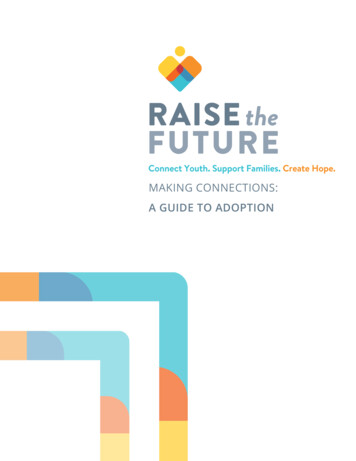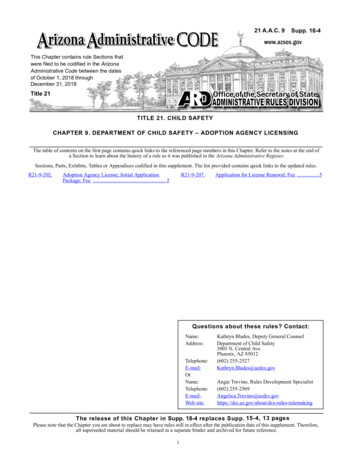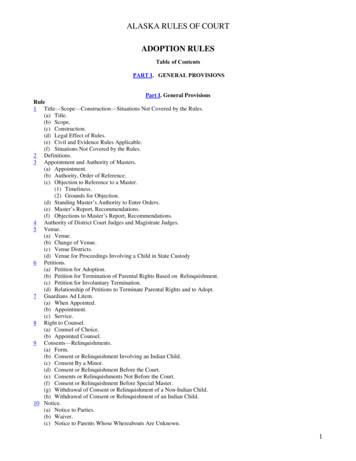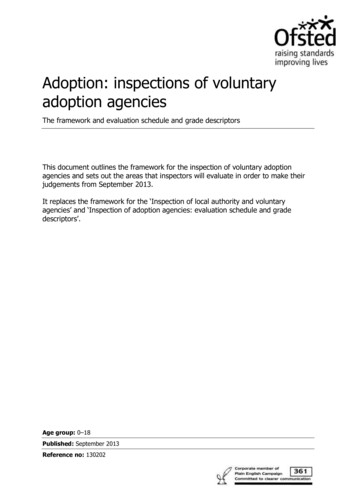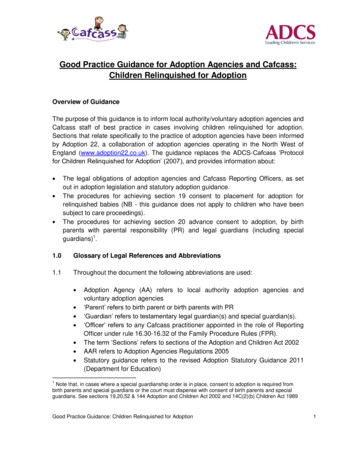
Transcription
Accelerate communicationsadoption through the powerof voice
Your colleagues need tobe convincedYou know the value of introducing new communicationtechnologies, but how can you be sure your colleagues willmake use of it?The business case is clear. You need greater collaboration - despitethe diverse working locations of your colleagues. You also knowbringing an application like audio conferencing in house could savecosts.The answer is making these technologies available to all.But there is an obstacle ahead. How can you ensure your colleaguesuse the solution you provide?10%1/3 of IT managers report thatfewer than 10% of workforceshave deployed UC. 1
Embrace the power of voiceNothing beats a conversation for effective communication.Studies consistently show that nothing is more effective thanvoice for clarity between two parties. IM, email, and otherelectronic media often evolve to a voice call to get a matterresolved. A good conversation is still the best way to get certainthings done.A positive first conversation experience will encourage yourcolleagues to further adopt your new communication tools.84% of enterprise workers surveyed prefer spokencommunication over written, claiming that it is “best forreal time answers,” with 83% saying it “gets my immediateattention” and 79% saying it “reduces uncertainty.”22
PTOADOPTION DRIVERS3AUDIO CONFEINGNCREORATIONBALOLTELEPHONYGet them talkingYour communications planning should start withvoice.Before you can boost adoption rates you need tobuild faith in your work amongst your colleagues.Providing effective means for your team to hear andbe heard will improve the likelihood they will embraceother tools in your UC rollout.To do this you need to ensure flexibility and audioquality whatever the environment. You need theability to move, to multi-task and to removebackground noise. You need headsets.In a survey of UC decision makers, Frost &Sullivan reports that 52% have evolved theirdesk-phone paradigm, with 76% replacingthose phones with a headset. 33C
Voice brings people togetherSpeaking is still preferred to email by many employees.Successful Unified Communication rollouts start with greataudio designed with collaborative working in mind.Why do Frost & Sullivan call the UC headset “critical enterprisecommunications?” Because it4 can:Better audio improves understanding in conference calls,catch-ups and brainstorming sessions. Seamlessly elevate an IM to a video session or call — from the sameaudio device Integrate audio across platforms, from mobile client to deskphone tosoftphoneWhen users have an easy, intuitive experience of highquality voice working within UC, their enjoyment will driveadoption of other UC tools. Automatically update presence Perform remote call control4
Plantronics makes things easyOur headsets have been developed with the best platforms in mind.We’ve been working closely with top providers such as Avaya, Cisco andMicrosoft since the birth of Unified Communications. It means we design ourproducts side-by-side, ensuring compatibility.For your users, this will mean a more intuitive everyday experience becauseboth audio device and platform were built with each other in mind. And for you,this means ease of implementation and fewer complaints.“The partnership betweenMicrosoft and Plantronicsis critical because ITmanagers do not want tobe system integrators.”–Gurdeep Pall,Corporate Vice President,Lync and Speech Group,Microsoft Corporation5
The future sounds goodOur audio is ready for what’s next.As you deploy your communications tools, you’ll know you need to think about how they’llbe used in the years ahead.One way to avoid obsolescence is to choose audio devices that will adapt as the world ofUnified Communications evolves. Plantronics can remove the worry you may have aboutreplacing headsets to accommodate a new platform requirement.Many of our headsets have contextual intelligence capabilities built in, and our Spokessoftware development platform enables the headset to control and enhance certain UnifiedCommunication functions.Features like these take our headsets beyond quality audio alone and deliver solutions thatboost productivity, efficiency, and ease of use — all of which will help drive your colleaguesinto using your UC solutions.By 2015 UC systems that do not support context-aware technologywill be abandoned for those that do.56
Plenty of companies have employees unwilling to embrace UnifiedCommunication methods. Don’t be one of them.Recognise the most popular Unified Communications are voicedependent and invest in Plantronics headsets for a superior audioand hands-free experience.Once your colleagues feel the benefits of seamless, trouble-freeintegration with their devices and working style, they’ll be far morelikely to adopt and recommend your plans across the rest of theorganisation.“.the continued growth of UC.has transformed theheadset from a mere auxiliary device into an intelligentendpoint with sophisticated functionality.”– Frost & Sullivan7
We make it simple for IT departments to deploy voice solutions andto use them as a catalyst for wider communication adoption. Ourtools and tactics will help you simplify the complexities and let yourpeople hear and be s Cited1, 3. InformationWeek Reports, “State of Unified Communications,” MichaelFinneran (April 2013).2. “How We Work: Communication Trends for Business Professionals,” Survey byPlantronics of 1,800 enterprise knowledge workers (September 2010).4. Frost & Sullivan, “Global Office and Contact Center Headset Market. HeadsetsBecome a Critical UCC Tool.” (December 2012).5. Gartner, “Predicts 2013: Success in Leveraging UC Will Be Easier With a UnifiedIT and Business Strategy for Collaboration” (December 2012). 2016 Plantronics, Inc. All rights reserved.8
Microsoft and Plantronics is critical because IT managers do not want to be system integrators." -Gurdeep Pall, Corporate Vice President, Lync and Speech Group, Microsoft Corporation We've been working closely with top providers such as Avaya, Cisco and Microsoft since the birth of Unified Communications. It means we design our


